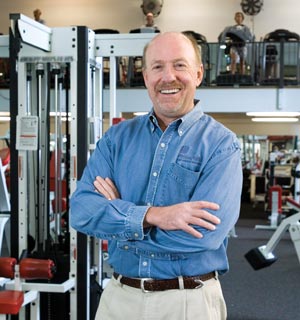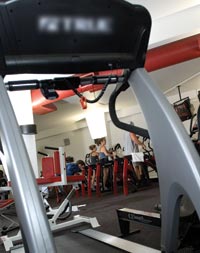|
MARKETING Insuring the fitness craze Health clubs: A market that continues to grow and mature By Dennis H. Pillsbury
For those of you who, like myself, are older than dirt, you can remember the days when health clubs were a complete misnomer. There was little healthy about them. The swimming pool, if there was one, and the shower area were unauthorized biological experiments. The olfactory senses were assaulted by unpleasant memories of high school locker rooms. The people who survived were indeed among the toughest and fittest. Members normally came from a group of carefully selected people who happened to receive a coupon in the mail that allowed them to purchase a lifetime membership for $10.50—a marketing plan conceived by the brother-in-law of an owner whose understanding of how to run a health club was based on his once having hoisted a barbell. Too often, unfortunately, members would show up for a workout only to find chains and a notice from the IRS on the door. As it turned out, a lifetime membership referred to the club’s lifetime, not their own. But the health club industry has matured. Although there continue to be some clubs that are maintenance-challenged, in general, most clubs are well maintained, with modern, up-to-date equipment; slip-proof tiles in the pool, hot tub, and shower areas; and numerous amenities that are related to the maintenance of an individual’s health and well-being. Not surprisingly, this has led to greater interest on the part of the insurance industry, which had formerly looked at health clubs as something to be avoided. There now are insurance companies and agents/brokers that have developed an underwriting expertise and knowledge of the business that was forged in the health club industry’s salad days. InterWest Insurance Services, Inc., an independent agency based in Sacramento, California, became interested in the health club market back in the mid-1980s, according to Jim Foley, CPCU, vice president and producer. “We’ve always sold on a retail basis, primarily writing small and medium-sized accounts. We got interested in this business when it was a fairly new industry and a tough class of business. We were able to convince Industrial Indemnity to take it on as a focused program where the underwriting requirements were quite stringent. The club had to own its real estate. We found that tennis and racquetball clubs usually had a substantial investment in their property and were of interest to Industrial. They provided us with an exclusive program designed for health clubs.
“We were able to make an immediate splash through word of mouth,” Jim remembers. “We have been associate members in IHRSA (International Health, Racquet and Sportsclub Association) since 1987, and this year will mark the 20th year that we have exhibited at its trade show. IHRSA was founded in the early ’80s to represent clubs that were financially stable, generally owner-operated, multi-amenity, clean, safe, well-staffed, and member-service oriented. We used an IHRSA membership list to conduct a survey of over 100 clubs and relied heavily on their feedback to design the underwriting template and coverage program with Industrial. Many of the clubs that responded became clients and still are today.” In the late ’80s, InterWest decided to expand its program outside of California and had to find a market other than Industrial Indemnity. The agency has used several companies since then and, today, provides coverage through several carriers, as well as the managing general underwriter, K&K Insurance Group, Inc., Fort Wayne, Indiana, one of the largest providers of sports-related coverages. “All the providers can accommodate our program,” Jim says, “and most of the business can be written in the standard market.” He continues, “We also can write off-site events that have appropriate controls in place.” These include fun runs and other club-sponsored events. “One of the value-added services we offer that serves to differentiate us from the competition is our Risk Assessment Management Program (RAMP). We work with the clubs to develop risk management checklists, provide safety sweeps, and help mitigate risks when loss runs indicate problems in particular areas.”
Lou Valentic, chief marketing officer with K&K, says the health club business is a “big part of our recreation business. It is a viable book for us in an industry that continues to expand. We’ve been in this business for more than 10 years and write millions of dollars of premium across the country on several hundred health clubs. (Like InterWest, K&K also is a member of IHRSA.) “The clubs that we look for are the full-service clubs,” he continues, “where fitness is the primary focus. We can and do cover ancillary services, such as eating facilities, spas, and baby-sitting—but they must be exactly that, ancillary to the fitness component.” Missy Ross, senior underwriter in the recreation unit for K&K, adds, “We’re looking for clubs with circuit training, cardio machines, racquetball, tennis, running tracks, rock climbing walls, etc. Pools are fine, as long as diving boards are limited to one meter in height only. Clubs really are getting better at managing their risks. We’re not seeing many slips and falls in the pool area. We also don’t require a lifeguard unless there are children in the pool.” She goes on to describe the coverages offered as part of the K&K program. These include “property from $1 million to $100 million, BI, personal property, inland marine coverages, crime, auto, and general liability up to $25 million. Workers comp is available in some states. We also offer garagekeepers liability for clubs that have valet parking for members.” Lou adds, “One of the unique features of our program is there is no aggregate. That’s a real advantage to the club owner and also an advantage when attempting to place excess layers. “We’re also a market for new ventures,” he continues. “However, we require a little additional underwriting information and a minimum premium of $5,000. “In underwriting this business, we look at the experience of the owner/operator, the staffing, certification of instructors, and whether there are people present whenever the club is open. We will not insure facilities that allow members to use keycards to enter during off hours when there is no supervision. We also check to make certain that the club requires members to sign waiver and release forms. If the club uses outside trainers, we require evidence of insurance from the outside trainers. By the way, we can help the club with that. We have a professional liability program for personal trainers that is written out of another division.” Lou concludes: “Our business is written exclusively through agents and brokers, and our health club program is one of the leading programs we discuss with agents. We also offer a community center program that can provide similar coverages. “We use ACORD forms for some parts of the program and others have specific applications that are unique to K&K. They are available online at www.kandkinsurance.com.” InterWest’s Foley points out that the increased attractiveness of the market has produced concomitant interest from insurance companies that were not markets in the past. “This new competition is putting pressure on pricing,” he says. Other emerging areas for consideration, he adds, are the increased use of automatic external defibrillators (AED) at health clubs, necessitating proper training on that equipment, and the need for Good Samaritan protection in those states that still have not enacted such legislation. * |
|||||
|





